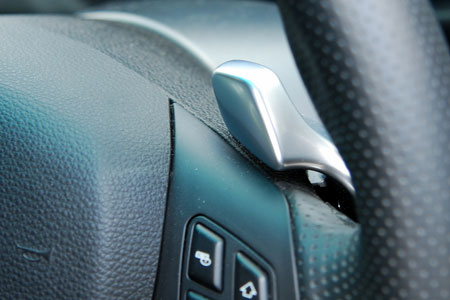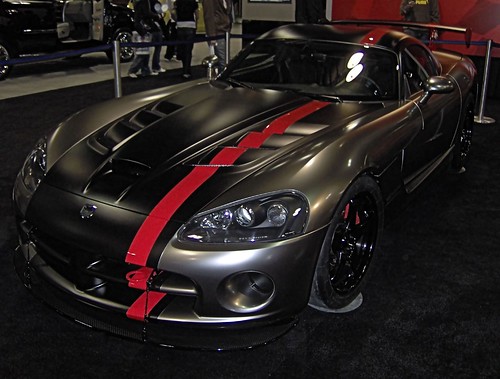The fact is that while American cars have been catching up to their import competitors by leaps and bounds in recent years, it takes quite a while for public perception to do the same. So without further ado, I present to you a list, by segment, of American cars you should go out and buy right now. Oh, and as my mother once said, "Do as I say, not as I do." ;-)
Saturn Astra: Although GM has clearly starved its Saturn arm of marketing muscle, the fact is many of its new cars are winners. This is especially true of the Astra, which as brought over pretty much as-is from Europe, where it competes with the top-selling VW Golf and the superb Euro Ford Focus. It's a bit of a step down from those expensive competitors, but a big step up from the compacts the US market is used to. It combines handsome looks with lively handling, high efficiency and great space usage to give compact buyers the total package.
Chevy Malibu: This car is quite simply one of the best competitors in the midsize segment. It matches or surpasses the Japanese leaders in style, handling and value, and is a major leap forward for the General in this segment.
Pontiac G8: GM's answer to the Chrysler 300, this one has a more widely appealing style (well, at least it'll age better, I think), and better handling. It's basically a BMW 5-Series on a budget, and is what the Pontiac brand should be all about. Ooh, and soon you can get it with a truck bed out back, a la El Camino. Word.
Pontiac Solstice/Saturn Sky: These roadsters were Bob Lutz's first brainchild when he got to GM, and they're still as exciting as they were then, especially in GXP/Red Line forms. But grab one fast, because GM is not planning to renew their lease on life.
Chevy Corvette: This is all-around the best sports car value on earth. Coming in flavors varying from awesome to double-awesome Z06, to triple-super-throwdown-awesome ZR1, these cars regularly match the performance of those costing twice as much. Not to mention their beauty and their amazing efficiency (26 highway for a 430-hp pushrod V8?!!).
Saturn Vue: Another rebadged Euro product, this CUV is attractive and upscale. Too bad, once again, that GM has choked off the division's marketing juice.
Ford Edge: This crossover is handsome, handles well and has Ford's great 3.5L V6, the American answer to the Nissan VQ, but smoother. When I was at the ad agency, I even got to work on claims that it's faster than a BMW X5 or Porsche Cayenne (the V6 models, of course).
Ford Flex: If that's your style (it's certainly not mine), then this is a great vehicle. The interior package is amazing, despite its lower roofline than competitors like the GMC Acadia and Honda Pilot. The materials they use are fantastic, it has that same 3.5L V6, and it also boasts some really cool features, like the Sync multimedia system and an in-car fridge...and you can get a contrasting white roof, just like on a MINI!
Jeep Wrangler: I recently had the pleasure of taking one of these things off road at Chrysler's Chelsea Proving Grounds, and it was a blast. The thing is so ultimately capable, and it's stayed true to its roots all these years. And now you can get one with four doors.
Dodge Ram: I haven't driven it myself, but my colleagues tell me it's the best-riding truck out there, thanks to its now coil spring rear setup. Amazingly, they did it without any degradation to the previous truck's capabilities. Add to that the new actually-attractive interior and innovations like the Ram Box bed-side storage, and we have a winner.
Ford F-Series: These trucks are tougher than a mofo. At the agency I got a chance to hear about the durability testing they put 'em through, and it did more damage to the engineers inside than the truck itself. It's pretty brutal. Their capabilities are unmatched by anything of similar size in the world, and the new generation of Power Stroke diesels is not only brutally torquey, but clean as a whistle. If only they weren't ugly...
Cadillac CTS: I while ago I posted that this was the first American car I'd actually buy myself. The rest of the cars on this list are great cars, but they just don't suit my taste. But this one, well it's got great looks, a phenomenal interior, a powerful direct-injection V6 available with a stick, and a great sport suspension. This is a fantastic car.
Lincoln MKS: This is a perfect example of a great car for other people, but not for me. We drove it back to back with the Lexus GS, and this car blew that one out of the water in several ways. The interior is top notch, and it's got great looks. With the available AWD and 20" wheels, it makes no difference that it's based on the Taurus' front-drive platform. Though that happens to be one of the safest in the world. This is what a Lincoln should be.
Buick Enclave: This is the best value in luxury CUVs, even though many buyers won't give Buick the credit it deserves because of recent history. The Enclave is gorgeous inside and out, and it shares the space efficiency and solid feel of the rest of GM's Lambda large crossovers. It may seem pricey for a Buick, but it's dirt cheap compared to an Audi Q7. Maybe people will chuckle at the country club, but we all know your self esteem is more secure than that.
Coming soon--the Ford Fiesta: Don't laugh. This isn't your hippy cousin's ratty old Fiesta. This is the most exciting small car on this side of the Atlantic since the Mini Cooper. You may have noticed that my list of cars was dominated by GM, while Ford has the edge (no pun intended) in trucks and CUVs. But Ford is about to unleash a slew of sweet rides, including the Euro Fiesta and Focus. The Fiesta comes first, and it'll blow the Chevy Aveo sky high, with great styling, great handling and a great interior. It's grrrrrrreat!
So get out there and BUY BUY BUY!!!
































 BMW also agrees in this regard, as they've been laying out their manumatics this way for years. Where BMW falls flat is in their steering wheel paddles. The Bavarians believe that you should be able to upshift or downshift with either hand, and it's a solid idea, until you come upon their solution for this. Each paddle in a Bimmer can be pulled with the fingers (for an upshift) or pushed with the thumb (for a downshift). While this does feel inherently intuitive, especially as it matches up with the shift lever, its downfall is in the thumb activation. When your hands are in a natural driving position, a yank on a paddle is natural and easily executed. But as I found in the X6 I drove yesterday, the downshift was another story, especially during spirited driving. The thumb extension felt strained and awkward, twisting my wrists into unnatural positions. You may think this is nitpicky and stupid, and I'll admit that I'm the prince of piddling pet peeves, but it did make me feel less in control and legitimately reduced my enjoyment of the drive.
BMW also agrees in this regard, as they've been laying out their manumatics this way for years. Where BMW falls flat is in their steering wheel paddles. The Bavarians believe that you should be able to upshift or downshift with either hand, and it's a solid idea, until you come upon their solution for this. Each paddle in a Bimmer can be pulled with the fingers (for an upshift) or pushed with the thumb (for a downshift). While this does feel inherently intuitive, especially as it matches up with the shift lever, its downfall is in the thumb activation. When your hands are in a natural driving position, a yank on a paddle is natural and easily executed. But as I found in the X6 I drove yesterday, the downshift was another story, especially during spirited driving. The thumb extension felt strained and awkward, twisting my wrists into unnatural positions. You may think this is nitpicky and stupid, and I'll admit that I'm the prince of piddling pet peeves, but it did make me feel less in control and legitimately reduced my enjoyment of the drive.
















